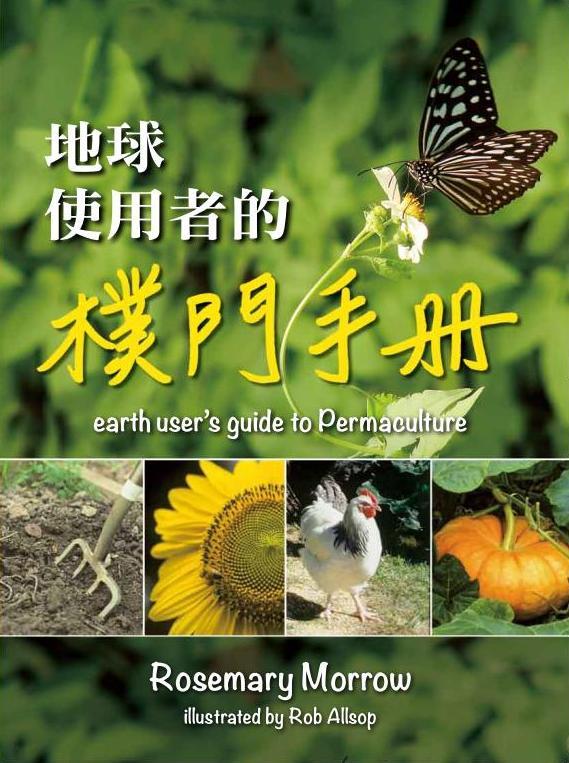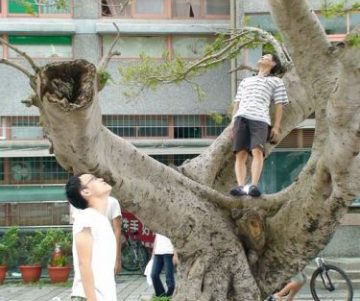感謝凱西和玉華帶領的樸門讀書會,這一天的主題是氣候與微氣候,在Earth Users’ Guide to Permaculture一書中(Rosemary Morrow著),談到關於降雨、土壤、建築、植被及坡度如何影響一地微氣候的種種因素。要瞭解一地之微氣候,可以嘗試一個很好的練習,你可以選擇某一天的不同時刻,閉上眼睛在你的土地上走一圈,深入感受那裡的冷熱、濕度、風向、亮度、太陽的方向與角度,以及周遭的植被等。當你閉上眼讓人帶領繞行你的土地時(請小心腳步!),依憑著周遭的微氣候,你就能夠知道樹木在哪裡,也可以感受到地面上的濕氣。這些感受都將協助你選擇最適合種植於此的植物,也能幫助你想像這些樹木在十年後將營造怎樣的微氣候。
Thanks to Kathy and Yuhua for leading yesterday’s permaculture study group! The topic was climate and microclimates, and the book (Earth User’s Guide to Permaculture, Rosemary Morrow) talked about how precipitation, soil, structures, vegetation and slope have different effects on local microclimates. When getting to know your local microclimates, a good exercise is to walk around the site at different times of the day and often close your eyes to get a good feel of coolness, moisture, wind, light, sun angle, slope and nearby vegetation. When you close your eyes and have someone lead you around the land (carefully!), you can feel where trees are just by the microclimates they produce. You can also feel the amount of moisture in the ground. This helps in designing which plants are most suitable for an area, and helps you think into the future about the microclimates produced in 10 years by trees you grow now.

Rosemary Morrow的書中也提到應用植物所創造的微氣候進一步協助其他植物生長的方法。關於這點,我想要分享最近在台東家院子裡所得到的經驗。當我們二月份租下這間房子時,院子裡除了石頭和砂土外,可說是什麼也沒有。由於缺乏植被,也沒有任何東西屏蔽從太陽,以及從地面、建築物、圍牆反射來的輻射熱,院子裡的微氣候真的非常非常地乾燥,在房子的任何一個角落都很悶熱,我都只能以「不宜人居」來形容。要改善如此環境的第一步,我想應該為房子多增加些遮蔭,並盡量從土地上獲取濕氣,我發現,雜草其實非常擅長這項工作。
Rosemary Morrow’s book mentioned a strategy for using plants to create microclimates that assist other plants to get started. I can share a recent experience of this on our yard in Taidong. When we rented the house in February, the yard was completely bare – only rocks and sand. This produced a very dry microclimate and because there was no vegetation, there was nothing to block radiation from the ground, the building, the garden walls and the sun. It was easy to feel this radiant heat from all sides, and I can only describe the feeling as “inhospitable.” The first step was to get shade and moisture in the ground and I found weeds to be the best at doing this job.
「什麼也不做」策略/A Do Nothing Strategy
因為平常都被綁在台北,我的第一個策略很不得已的只能是「什麼也不做」,不過雜草們還滿喜歡這個策略的,它們很成功地霸佔了所有空間,將全部地面都覆上了一層植被,抵擋住陽光的強力照射進而將下了院子裡的溫度。這些雜草創造了一種很有助益的微氣候。
雖然這個策略看起來好像是個懶人作法,但其實什麼也不做還滿困難的。我的房東一直問我是不是要灑灑除草劑剷除這些雜草,我的朋友鄰居不斷地說這些難看的雜草讓院子看起來好像一塊荒地,如果「現在」不好好處理以後會衍生很多問題,有個鄰居甚至興奮地想要從我手上奪刀示範怎樣除草!所以「什麼也不做」策略的主要問題其實是社會與文化性質的。除此之外,這是我所知道可以加速演替,創造一個繁榮的可食生態系統的最好方式。
Often stuck far away in Taipei, my first strategy was naturally to do nothing. The weeds very much enjoyed this strategy. They did a wonderful job at filling all spaces and providing a vegetative ground cover. This greatly cooled down the yard and reduced the sun’s glare. The weeds created a microclimate – a very beneficial microclimate. Although it may seem like a lazy thing to do, it wasn’t easy to “do nothing.” My landlord continually asked me if she could spray herbicides to fight the weeds. My friends and neighbors said it looked like a wasteland with all those unsightly weeds and said I would have lots of problems down the road if I didn’t “take care of” them now. One neighbor got so excited that she wanted to take my culling knife out of my hands and show me how to cut the weeds down! So the main problem with this strategy is socio-cultural. Apart from that, it is the best strategy I know of to accelerate succession and create a thriving edible ecosystem.
雜草可以提供下列幾項好處:Here are some of the benefits that these weeds offered:
其他策略/The Rest of My Strategy


雜草是我「什麼也不做」策略的基礎,因為它們提供了太多好處。每次去台東我都只擴充了大約幾平方公尺的菜園,還沒有特別照顧到的部份,就任憑雜草繁茂生長,我很尊敬它們為我做的所有工作。無論地上地下,它們都將我的院子轉變成一個充滿生命的空間。唯一我會連根拔除了是蒺藜草,因為它長滿棘刺的種子碰到很痛;唯一我會阻止繁衍的是咸豐草(為什麼?),每次我剛抵達台東和離開前都會摘下它們的花。這兩項工作每個月大概只花我十分鐘,其他策略就是逐漸蒐集營造菜園所需要的材料,例如廚餘、厚紙板、覆蓋物,以及外移的土壤等。我只會在擴充菜園面積時才會除去雜草,而且隨即會依序撲上廚餘、紙板、覆蓋物和土壤,很快就能在我的雜草朋友的繁榮世界旁邊創造一個菜園,前文已經說明過這個菜園前期雜草生態系統的優點。這個雜草生態系最終還是會被可食植物所取代,不過如果它們又長回來了也不必發瘋,因為雜草總是會好好地做好它們的工作,也很容易管理。雜草真是我的好朋友!
The weeds were an essential part of my “do nothing” strategy, because they provided so much (see above). Every time I go to Taidong, I expand the garden by a few more square meters. In spaces where I haven’t yet expanded my garden, I continue to let the weeds thrive and I greatly respect the job they are doing for me. They are turning my yard into a livable space, both above and below ground. The only weed that I pull out by the roots is JILI, which produces a painful hitchhiking seed. The only weed that I don’t let germinate is 咸豐草, which I deflower by hand once upon my arrival to Taidong, and once upon my departure. This pulling and deflowering takes about 10 minutes per month. The rest of my strategy is to gradually gather all the materials I need for expanding the garden (kitchen scraps, cardboard, mulch, transplant soil), and all at once cut down the weeds only
as far as I need to expand the garden, and put down the kitchen scraps, cardboard, mulch and transplant soil (in that order). The result: an instant garden right next to a thriving ecosystem created by my weed friends. The benefits of this pre-established ecosystem are stated above. Eventually, the weeds will be replaced mostly by food plants, but there’s no need to freak out when some of them come back because they are always doing a good job for me (see above benefits) and they are easy to manage. Weeds are my friends!!!
更多關於微氣候/More on Microclimates
植物是微氣候最好的創造者,如果擁有足夠的空間與時間,植物,特別是樹木,擁有大幅改變地貌及氣候的驚人能力。前文中,我已經分享了如何讓雜草為我的菜園創造一個良好微氣候與生態系,下面則繼續和大家分享如何利用微氣候幫助我的日常生活:
I think that plants are the best creators of microclimates. Plants, and especially trees, have amazing qualities to greatly alter the landscape and climate… if we let them. Above, I have shared one way that I allow weeds to create a beneficial microclimate and ecosystem for my garden. Other ways that I use microclimates in my everyday life:
我選擇這塊土地的其他重要原因還包括個人健康的因素(我在台灣北部及中部常犯氣喘)、到鄰近村落的便利性(經濟社會環境)、友善體力的地形(沒有山丘)、價格,以及與海的距離等等,不過個人健康和鄰近村落的距離是最主要的考量。最後我仍要強調:樸門永續設計的原則與策略幾乎可以將所有土地營造成具生產力又宜人居的地方!
Just to let readers know, other important factors that led me to choose this site were personal health reasons (chronic asthma in Northern and Western Taiwan), proximity to villages and access routes (economic/social livelihood), human-power friendly landscape (no hills), price, and distance from rising ocean. Personal health and social livelihood were predominant factors for choosing this site. It is important to stress here that permaculture principles and strategies can make almost any piece of land productive and livable!



